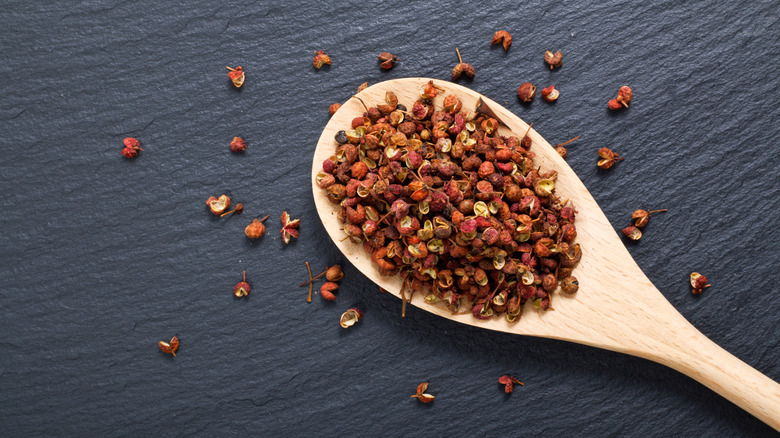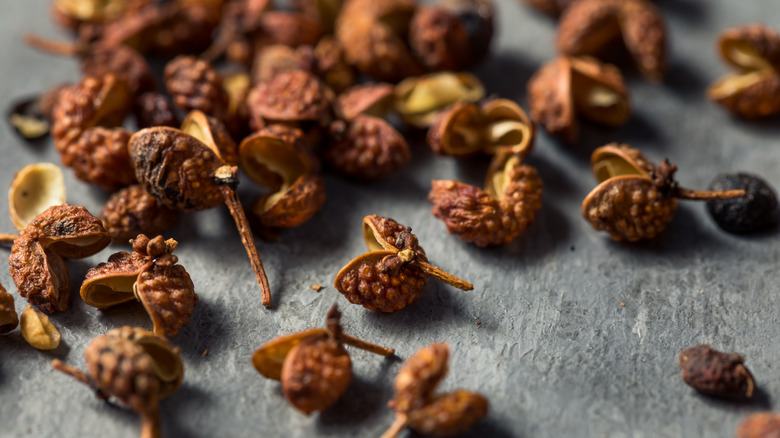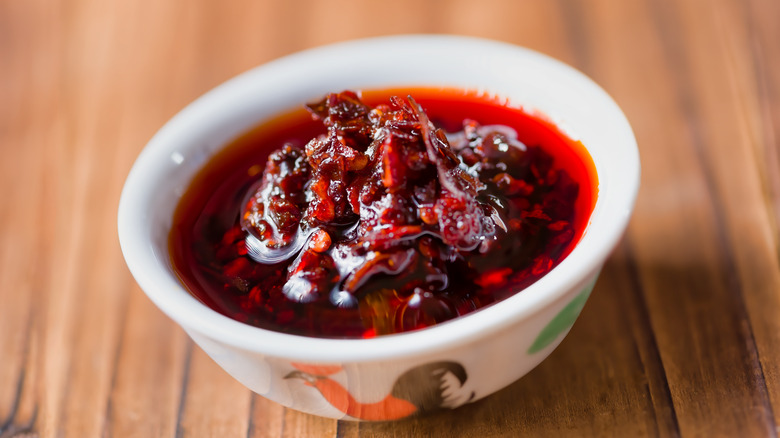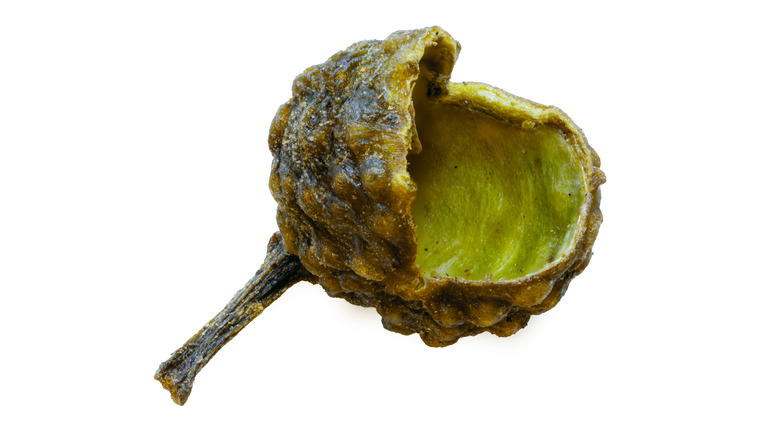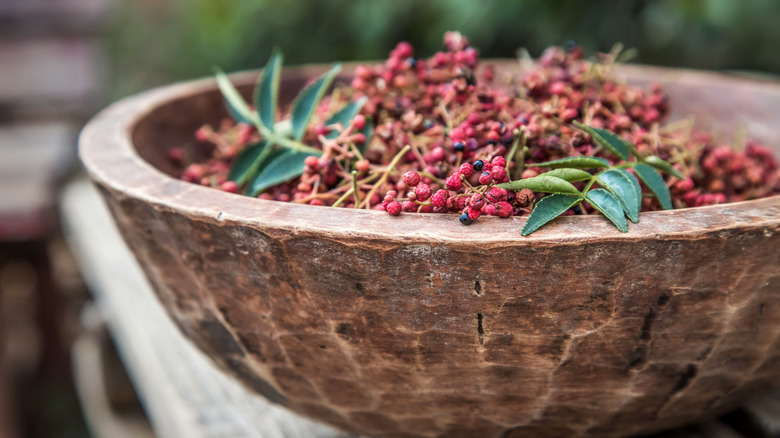What Makes Sichuan Peppercorns Unique?
Chinese cuisine is highly regional, with a dazzling assortment of styles, tastes, and techniques found throughout the nation. From the light, flavorful, and umami-emphasized foods of the Fujian province to the world-famous wok and Dim Sum dishes found in Cantonese cuisine, it's safe to say the country is an enthralling place to eat (via Hakkasan).
Inside China, Sichuanese food is the most popular of the regional cuisines. Not only does the region comprise the largest sector of food deliveries in China, but Sichuan province's capital Chengdu became the first city in Asia to receive a UNESCO gastronomy designation, notes Radii. A fertile, damp part of the country, the food utilizes every range of tastes, incorporating spicy, floral, sweet, bitter, and smokey flavors — sometimes all at once. One of the cuisine's most fundamental ingredients is the Szechuan peppercorn, per Serious Eats. So let's dive into this unique spice — both numbing and floral, it's an ingredient unlike anything else.
What are Sichuan peppercorns?
Despite their name, Sichuan peppercorns are unrelated to black peppercorns and chile peppers. Instead, the spice covers several plants in the Zanthoxylum, or prickly ash species, part of the citrus family (per Britannica). Their taste is floral, sometimes described as lavender and pine, with some citrus fruit sweetness in the background (via Spiceography). A component in Chinese five-spice, Sichuan peppercorns are the dried husks surrounding the seed. They're used in both powdered and whole form, notes The Spruce Eats.
Most notably, Sichuan peppercorns are known for their unique numbing and tingling sensations. Reminiscent of a carbonated beverage or Pop Rocks, their qualities may come across as heat-like, but their mechanism is the opposite of capsicum. These husks contain a chemical compound that initiates minuscule vibrations across the tongue and lips. Operating like a local anesthetic, these properties block out flavors, making them a popular pairing with spicy chilies in Chinese cuisine, explains Britannica. Such a quality enables fascinating flavors in the kitchen — let's explore how to use them.
How to cook with Sichuan peppercorns
In Sichuanese food, the balance of the peppercorn's numbing sensations combined with chili peppers' spiciness is known as málà. A tenet of the cuisine's complexity, this flavor dichotomy means that the spice can add a multi-dimensional component to everything from broths and cold noodles to pastries. Chili oils and spice blends are an especially popular vessel for flavor integration, notes Bon Appetit.
It's best to buy peppercorns whole for the most variability. They can be cooked in oil and strained to impart a flavor or tossed into a stir-fry — although whole peppercorns can be uncomfortably crunchy. For easier integration, toast the husks, and grind them with a mortar and pestle. Keep in mind their numbing qualities are not noticeable when small amounts of peppercorns are used. For some recipes, like in a marinade, the numbing effect is not intended, explains The Woks of Life. Sichuan chili oil, like in a base of a dry hot pot, is an especially good starting point for sampling the spice. Plus, it can easily be stored and drizzled on top for an aromatic kick.
Varieties of Sichuan peppercorns
With several plants encompassed in the Sichuan peppercorn name, there are more than 60 variations of the spice. The most popular is the large, red kind — what most cooks associate with the name. For culinary uses, seek out the Da Hong Pao type, translated as the red robe. These husks feature a citrusy, slightly wood-like flavor with a pleasant warmth perfect for dishes. Another common red variety is Hanyuan, which boasts a brighter, more floral taste, with the berry smaller and darker in size (via The Mala Market).
Green Sichuan peppercorns are a different variation of the plant, not an underripe berry, as some believe. They numb the tongue more than their red counterparts, and deliver a lemon-like aroma, notes Mala Eats. With a piney, minty flavor, some even compare them to breath mints — a world away from the taste of the red peppercorns. In Japan, yet another kind of Sichuan peppercorn is called sansho. This type highlights the citrus flavor without the numbing, perfect as a topping for noodles, or tofu, explains Viet World Kitchen.
Buying Sichuan peppercorns
Not all Sichuan peppercorns are created equal — it's necessary to select carefully for optimal flavor. The husks are most aromatic when recently picked, and their freshness can be determined by numerous factors. Check for a bright color, red or green, depending on the variety, with darker hues showing staleness. Additionally, the spice should be very fragrant, with the aroma palpable even when the package is unopened, reports China Sichuan Food.
Sichuan peppercorn sale was prohibited in the U.S. until 2004 due to fear of a citrus tree canker spreading alongside the spice (via New York Times). As a result, they can still be tricky to find, although increasingly prevalent in gourmet groceries, Chinese supermarkets, and online. The Woks of Life recommends purchasing the spice online for the freshest quality and largest selection. Plus, it's easier to purchase in bulk — unground Sichuan peppercorns will last for a few years in an airtight container.
